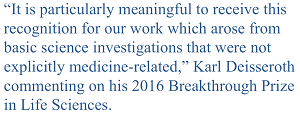Last week, the Breakthrough Prize organization announced the recipients of the 2016 Breakthrough Prize in Life Sciences, Fundamental Physics and Mathematics. The 3rd annual Breakthrough Prize Awards Ceremony awarded 1,370 physicists, one mathematician, five life scientists, and one high school student with a combined total of $21.9 million.
This year is a proud one for brain science: three of the five recipients of the 2016 Breakthrough Prize in Life Sciences were neuroscientists! Dr. Karl Deisseroth of Stanford University and Howard Hughes Medical Institute and Dr. Edward S. Boyden of the Massachusetts Institute of Technology each received $3 million for their pioneering work in optogenetics, a set of tools and techniques for programming of neurons to express light-activated ion channels and pumps, so that their electrical activity can be controlled by light. Deisseroth and Boyden’s technique has truly transformed the way neuroscientists study brain circuitry and set the stage for The BRAIN Initiative®.
Not only should Boyden and Deisseroth be lauded for developing and continuously refining what has become—in just the past decade—one of the most ubiquitous (and powerful) sets of tools in science, they have also worked hard to make the tools accessible and easy to use. Deisseroth, for example, has organized a series of training courses to teach researchers optogenetic techniques.

Given the commitment NINDS has demonstrated in maintaining a robust basic science portfolio, I was delighted that Deisseroth cited support of basic science as an important factor that contributed to the development of optogenetics in his acceptance remarks.
Boyden’s acceptance remarks emphasized thegenerosity of his mentors, Drs. Dick Tsien and Jennifer Raymond, who encouraged him to pursue work on optogenetics, which he termed an “extracurricular activity”. It’s true that tool-making has for a long time been seen as secondary to making new discoveries. But now, as evidenced by the importance the BRAIN Initiative has placed on creating new tools and techniques for studying neural structure and function, today’s toolmakers are quickly becoming the rock stars of neuroscience.
I want to also congratulate Ed Boyden on his 2015 Society for Neuroscience Young Investigator Award, which recognizes the outstanding achievements and contributions by a young neuroscientist who has recently received his or her advanced professional degree. Boyden’s work on optogenetics was the basis for this award as well.
Dr. John Hardy of University College London, previously an intramural NIH investigator in the National Institute of Aging, also received the $3 million Breakthrough Prize for his work describing the first mutations in the gene that codes for the Amyloid Precursor Protein (APP) that cause early onset Alzheimer’s disease. John stressed the importance of team science in dissecting the cause of Alzheimer’s disease that will ultimately lead to better treatments, and perhaps one day, prevention.
On behalf of NINDS, I would like to extend warm congratulations to Drs. Deisseroth, Boyden, and Hardy for their rock star worthy work in neuroscience!
For those wanting to watch the Breakthrough Prize awards ceremony, which also celebrate achievements in mathematics and fundamental physics, it will air on FOX Sunday, November 29 at 7-8 p.m. ET/PT.
Read more about this year’s Breakthrough Prize awardees here.
